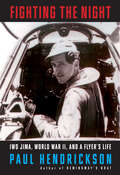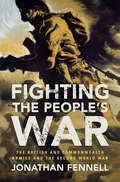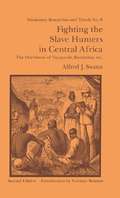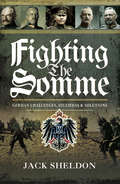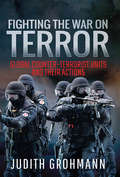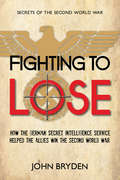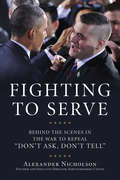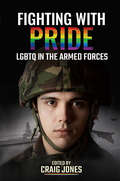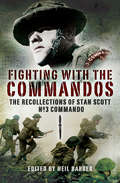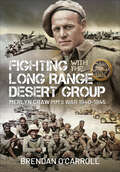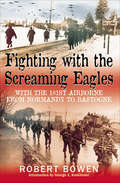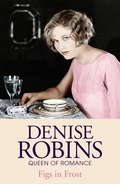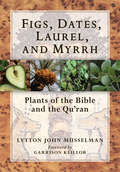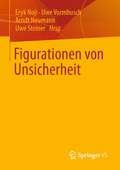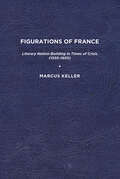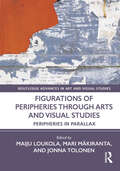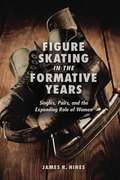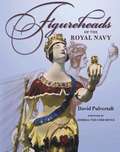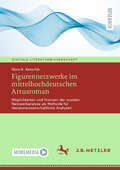- Table View
- List View
Fighting the Night: Iwo Jima, World War II, and a Flyer's Life
by Paul HendricksonFrom the acclaimed and best-selling author of Hemingway&’s Boat, the profoundly moving story of his father&’s wartime service as a night fighter pilot, and the prices he and his fellow soldiers paid for their acts of selfless, patriotic sacrificeIn the fall of 1944, Joe Paul Hendrickson, the author&’s father, kissed his twenty-one-year-old wife and two baby children goodbye. The twenty-five-year-old first lieutenant, pilot of a famed P-61 Black Widow, was leaving for the war. He and his night fighter squadron were sent to Iwo Jima, where, for the last five and a half months of World War II, he flew approximately seventy-five missions, largely in pitch-black conditions. His wife would wait out the war at the home of her small-town Ohio parents, one of the countless numbers of American family members shouldering the burden of being left behind.Joe Paul, the son of a Depression-poor Kentucky sharecropper, was fresh out of high school in 1937 when he enlisted in mechanic school in the peacetime Army Air Corps. Eventually, he was able to qualify for flight school. After marriage, and with the war on, the young officer and his bride crisscrossed the country, airfield to airfield, base to base: Santa Ana, Yuma, Kissimmee, Bakersfield, Orlando, La Junta, Fresno. He volunteered for night fighters and the newly arrived and almost mythic Black Widow. A world away, the carnage continued. As Paul Hendrickson tracks his parents&’ journey, together and separate, both stateside and overseas, he creates a vivid portrait of a hard-to-know father whose time in the war, he comes to understand, was something truly heroic, but never without its hidden and unhidden psychic costs.Bringing to life an iconic moment of American history, and the tragedy of all wars, Fighting the Night is an intense and powerful story of violence and love, forgiveness and loss. And it is a tribute to those who got plunged into service, in the best years of their lives, and the sacrifices they and their loved ones made, then and thereafter.
Fighting the People's War: The British and Commonwealth Armies and the Second World War (Armies of the Second World War)
by Jonathan FennellFighting the People's War is an unprecedented, panoramic history of the 'citizen armies' of the United Kingdom, Australia, Canada, India, New Zealand and South Africa, the core of the British and Commonwealth armies in the Second World War. Drawing on new sources to reveal the true wartime experience of the ordinary rank and file, Jonathan Fennell fundamentally challenges our understanding of the War and of the relationship between conflict and socio-political change. He uncovers how fractures on the home front had profound implications for the performance of the British and Commonwealth armies and he traces how soldiers' political beliefs, many of which emerged as a consequence of their combat experience, proved instrumental to the socio-political changes of the postwar era. Fighting the People's War transforms our understanding of how the great battles were won and lost as well as how the postwar societies were forged.
Fighting the Slave Hunters in Central Africa: A Record of Twenty-Six Years of Travel and Adventure Round the Great Lakes
by Alfred J. SwannThis volume deals mainly with Swann's life on and around Lake Tanganyika, a life that brought him knowledge of many African peoples living on the lake's shores. First published in 1910.
Fighting the Somme: German Challenges, Dilemmas and Solutions
by Jack SheldonA fresh look at the German defense in the WW1 battle, “jam packed with history [and] tons of firsthand accounts . . . superb” (A Wargamers Needful Things).Rather than a rehashed narrative history of the Battle of the Somme, this book draws heavily on examples that can be illustrated through exploitation of the primary sources still available in abundance in the archives at Stuttgart and Munich, as well as anecdotal accounts, to explain how and why the German defense was designed and conducted as it was. Fighting the Somme explores the reasons for the dominance of the Great General Staff; the tensions between commanders and staff; the disagreements between the commanders of First and Second Army; and the replacement of General von Falkenhayn with the duumvirate of Hindenburg and Ludendorff. Specific case studies include the loss and recapture of Schwaben Redoubt on July 1; the British assault on the Second Position of July 14; the tank attack at Flers of September 15, and the autumn battles for Sailly Saillisel and St. Pierre Vaast Wood. It shows how the various levels of command from regiment to army group operated and responded to emergencies and crises, and examines changes in command philosophy, the introduction of new weapons and equipment, and the evolution of tactics to counter the massive Allied superiority in manpower and materiel.
Fighting the War on Terror: Global Counter-Terrorist Units and their Actions
by Judith GrohmannSWAT teams, GSG9, EKO Cobra, SCO 19 these elite police units are used to dealing with dangerous situations, particularly in the fight against global terrorism. European political-economic journalist and author, Judith Grohmann, is the first outsider to be given access into the world of specialist counter-terrorism units in 16 countries around the globe, including the USA, Russia, Israel, the UK, and many more. Whether performing hostage rescues, subduing barricaded suspects, engaging with heavily-armed criminals or taking part in counter-terrorism operations, her interviews with the men and women concerned explain what their work really involves, their most dangerous missions, and the physical and mental training required for them to perform these high-risk operations, which fall outside the abilities of regular police officers.A truly intimate insight into a closed world.
Fighting to Leave: The Final Years of America's War in Vietnam, 1972–1973
by Colonel Robert E. StoffeyFrom a Vietnam wartime veteran and US Marine officer, an insider’s account of the final military strategies of the Vietnam war.Perhaps more vexing than any part of the Vietnam War—Americas longest—was getting out. This book offers a chronicle of those last difficult years, 1972 and 1973, that is at once a detailed and thorough overview and at the same time a vividly personal account. The year 1972 found Marine Corps pilot Robert E. Stoffey beginning his third combat tour in Vietnam.After flying 440 combat missions out of Da Nang and Marble Mountain Airfields in South Vietnam—and being shot down twice—between 1965 and 1970, Stoffey was in a unique position to judge the United States changed strategy. From the vantage point of the USS Oklahoma City, he fought—and observed—the critical and complex last two years of the war as Marine Air Officer and Assistant Amphibious Warfare Officer on the staff of the Commander, Seventh Fleet. As the South Vietnamese battled for survival against the onslaught from the Communist North Vietnamese Army, the US Seventh Fleet, afloat in the Gulf of Tonkin and the South China Sea, was a significant supporting force.With the US Navy’s mining of North Vietnams waterways, concentrated shore bombardments, and air attacks, this sea power was instrumental in leading to the negotiated end of the war and return of our POWs. This is the story that Robert Stoffey tells in his firsthand account of how the Vietnam War finally ended and what it took to get our POWs home.
Fighting to Lose: How the German Secret Intelligence Service Helped the Allies Win the Second World War
by John BrydenStartling new revelations about collaboration between the Allies and the German Secret Service. Based on extensive primary source research, John Bryden’s Fighting to Lose presents compelling evidence that the German intelligence service — the Abwehr — undertook to rescue Britain from certain defeat in 1941. Recently opened secret intelligence files indicate that the famed British double-cross or double-agent system was in fact a German triple-cross system. These files also reveal that British intelligence secretly appealed to the Abwehr for help during the war, and that the Abwehr’s chief, Admiral Canaris, responded by providing Churchill with the ammunition needed in order to persuade Roosevelt to lure the Japanese into attacking Pearl Harbor. These findings and others like them make John Bryden’s Fighting to Lose one of the most fascinating books about World War II to be published for many years.
Fighting to Serve: Behind the Scenes in the War to Repeal "Don't Ask, Don't Tell"
by Alexander NicholsonRevealing the backstage dealings that led to the 2010 repeal of the Pentagon's "Don't Ask, Don't Tell" (DADT) policy, Fighting to Serve offers a detailed, no-holds-barred account of the negotiations from an insider's perspective. In early 2006, Alexander Nicholson, the founder of the largest organization for gay and lesbian servicemembers--Servicemembers United--along with fellow former military members who had also been discharged under DADT, toured the United States, speaking about the destructive policy at American Legion posts, on radio talk shows, and at press conferences across the South and both coasts. Surprised at the mostly positive reception and momentum for the repeal that the tour provoked, Servicemembers United was suddenly propelled to the forefront of the fight to overturn DADT. From the unique perspective of the only person with a central role on every front in the war against DADT, Nicholson exposes how various LGBT organizations, Congress, the Pentagon, and the White House often worked at cross purposes, telling the public they were doing one thing while advocating other strategies behind closed doors.
Fighting with Pride: LGBTQ in the Armed Forces
by Craig JonesLGBTQ+ personnel who served in the British military despite the gay ban tell their stories in a moving testament to their patriotism and courage.On January 12th, 2000, the British Armed Forces took a major step toward greater equality by ending its restriction against members of the LGBTQ+ community. To honor that historic event, this volume presents the personal reflections of ten LGBTQ+ personnel who had served under the ban since the Second World War. All of them lived remarkable lives, though some were dismissed in disgrace or asked to resign because of their identity.These brave men and women tell of remarkable careers, courage in battle, and private lives kept secret at all cost. They include stories of serving on the front line of operations worldwide, including in the Second World War, the Falklands War, the Gulf Wars and the war in Afghanistan. This book celebrates their lives, as well as all servicepeople who have stood tall and taken their place with pride in the fighting units of the Royal Navy, Royal Marines, Royal Air Force and the British Army.
Fighting with Pride: LGBTQ in the Armed Forces
by Craig JonesLGBTQ+ personnel who served in the British military despite the gay ban tell their stories in a moving testament to their patriotism and courage.On January 12th, 2000, the British Armed Forces took a major step toward greater equality by ending its restriction against members of the LGBTQ+ community. To honor that historic event, this volume presents the personal reflections of ten LGBTQ+ personnel who had served under the ban since the Second World War. All of them lived remarkable lives, though some were dismissed in disgrace or asked to resign because of their identity.These brave men and women tell of remarkable careers, courage in battle, and private lives kept secret at all cost. They include stories of serving on the front line of operations worldwide, including in the Second World War, the Falklands War, the Gulf Wars and the war in Afghanistan. This book celebrates their lives, as well as all servicepeople who have stood tall and taken their place with pride in the fighting units of the Royal Navy, Royal Marines, Royal Air Force and the British Army.
Fighting with the Commandos: Recollections of Stan Scott, No. 3 Commando
by Neil BarberFighting With The Commandos tells what the Second World War was like for a fighting soldier. After enlisting underage, he was 'found out', joined the Home Guard and then a Young Soldiers Unit (for those too young to serve overseas). He managed to get out to Iraq but was again sent home.He then joined 3 Commando led by Brigadier Peter Young and landed on SWORD Beach on D-Day. He graphically describes the action thereafter which included being among the first to reach Pegasus Bridge and relieve the glider borne troops under Major John Howard. Plenty of excitement and danger were to follow and readers will revel in a no-holds-barred memoir which points an illuminating picture of life for the rank-and-file in the build-up to the climax of the war.
Fighting with the Fourteenth Army in Burma: Original War Summaries of the Battle Against Japan 1943–1945
by James LutoThe Fourteenth Army was one of the most successful British and Commonwealth forces of the Second World War. It was not only the largest of the Commonwealth armies but was also the largest single army in the world with around half a million men under its command. Operating in the most inhospitable terrain, it drove the previously undefeated Japanese Army from the Indian border and out of Burma in an unrelenting offensive.The Fourteenth Army, often referred to as the Forgotten Army, was made up from units that came from all corners of the Commonwealth and was composed of thirteen divisions from East and West Africa as well as Britain and India. After the defeat of the Japanese these divisions compiled a summary of its actions and it is these unique documents that form the basis of this new book.Presented here together then for the first time is the story of war against the Japanese as told by each of the divisions that fought in that bitter conflict the original and authentic accounts untouched by the pens of historians.These accounts can never be supplanted and will be an invaluable source of information for generations to come. It will also help the many millions of relatives of those men that fought with the Fourteenth Army understand the complex campaign of 1943-1945.The Fighting Divisions of the Fourteenth Army is completed with citations for those actions which saw the award of the Victoria Cross and detailed Orders of Battle throughout the Fourteenth Army's existence to make this the most detailed study of its kind.
Fighting with the Long Range Desert Group: Merlyn Craw MM's War 1940–1945
by Brendan O'CarrollFormed in 1940 the Long Range Desert Group was the first Allied Special Forces unit established to operate behind German and Italian lines in North Africa. Its officers and men were volunteers recruited from British and Commonwealth units. Merlyn Craw was serving with the 2nd New Zealand Expeditionary Force when he joined the LRDG in 1941. He took part in numerous missions in the desert. The navigational driving and fighting skills of the LRDG were legendary and they were frequently responsible for transporting Stirling’s SAS detachments on raids. Merlyn’s luck ran out when he was captured on the Barce raid in September 1942, but he escaped twice, the second time making it back to Allied lines. Sent home on leave, he returned to Italy with the New Zealand Army. After a ‘disagreement’ he went AWOL and rejoined the LRDG with no questions asked, serving until the end of the war. Drawing on interviews with Merlyn and other former LRDG veterans, the author has created a vivid picture of this exceptional and highly decorated fighting man. Readers cannot fail to be impressed by the courage and ruthless determination of Merlyn Craw MM and his comrades.
Fighting with the Screaming Eagles: With the 101st Airborne from Normandy to Bastogne
by Robert BowenA member of the 101st Airborne&’s Glider Infantry recalls WWII, from the horror of D-Day to the despair of Nazi captivity, in this compelling memoir. As World War II broke out, Robert Bowen was drafted into Company C, 401st Glider Infantry, 101st Airborne Division. Soon afterwards, he found himself storming Utah Beach amid the chaos of D-Day, through unfamiliar terrain littered with minefields and hidden snipers. Bowen was wounded during the Normandy campaign but went on to fight in Holland and the Ardennes, where he was captured. That&’s when his &“trip through hell&” truly began. In each of Bowen&’s campaigns, the 101st &“Screaming Eagles&” spearheaded the Allied effort against the Nazi occupation of Europe. At Bastogne, they stood nearly alone against the onslaught of enemy panzers and grenadiers. His insights into life behind enemy lines after his capture provide as much fascination as his exploits on the battlefield. Written shortly after the war, Bowen&’s narrative is immediate and compelling. An introduction by the world&’s foremost historian of the 101st Airborne, George Koskimaki, further enhances this classic work.
Figs in Frost
by Denise RobinsLucia marries young, yielding more to her parents urgings than the dictates ofher heart. As the years go by, she grows to despise her brutish, egotisticalhusband - finding contentment only in raising her two young daughters. Thensuddenly, Lucia falls gloriously in love, discovering the tenderness and blissshe has never even dared to dream of. And so her husband fights back with theonly weapon he has - forcing Lucia to choose between the children she cherishedand the man she loves...
Figs in Frost
by Denise RobinsLucia marries young, yielding more to her parents urgings than the dictates ofher heart. As the years go by, she grows to despise her brutish, egotisticalhusband - finding contentment only in raising her two young daughters. Thensuddenly, Lucia falls gloriously in love, discovering the tenderness and blissshe has never even dared to dream of. And so her husband fights back with theonly weapon he has - forcing Lucia to choose between the children she cherishedand the man she loves...
Figs, Dates, Laurel, and Myrrh: Plants of the Bible and the Quran
by Garrison Keillor Lytton John MusselmanThis book celebrates the plants of the Old Testament and New Testament, including the Apocrypha, and of the Quran. From acacia, the wood of the tabernacle, to wormwood, whose bitter leaves cured intestinal worms, 81 fascinating chapters—covering every plant that has a true botanical counterpart—tell the stories of the fruits and grains, grasses and trees, flowers and fragrances of ancient lore. The descriptions include the plants' botanical characteristics, habitat, uses, and literary context. With evocative quotations and revelatory interpretations, this information is all the more critical today as the traditional agrarian societies that knew the plants intimately become urbanized.The unusually broad geographic range of this volume extends beyond Israel to encompass the Holy Land's biblical neighbors from southern Turkey to central Sudan and from Cyprus to the Iraq border.Richly illustrated with extensive color photography and with a foreword by the incomparable Garrison Keillor, this delightful ecumenical botany offers the welcome tonic of a deep look into an enduring, shared natural heritage.
Figurationen von Unsicherheit
by Uwe Vormbusch Uwe Steiner Eryk Noji Arndt NeumannJede Zeit, jede Gesellschaft kennt ihre eigenen Figurationen von Unsicherheit. Der Band fragt nach den historisch variablen Strategien, Mechanismen und Kulturtechniken, mittels derer Gesellschaften Unsicherheiten thematisieren und bearbeiten. Solche Praktiken sind keineswegs durchgängig auf Unsicherheitsvermeidung bzw. -absorption ausgerichtet. Vielmehr existieren Strategien der Erzeugung und der Absorption von Unsicherheit parallel und verweisen aufeinander. Dieser Diagnose versuchen die interdisziplinären Perspektiven, die dieser Band versammelt, Rechenschaft zu tragen. Geschichtswissenschaften, Literatur- und Medienwissenschaften, Philosophie, Psychologie, Soziologie – sie alle haben eigene Zugänge zum Phänomen der Unsicherheit. Dies zeigt sich auch in der Bandbreite der hier verhandelten Themen: das Entscheiden und Nicht-Entscheiden, Algorithmen und Prognosen, Prävention und Fiktion, Erfahrungsgeschichte, Emotionen und politische Repräsentation, Self-Tracking, Bewertung und Lernen.
Figurations of France: Literary Nation-Building in Times of Crisis (1550-1650)
by Marcus KellerIn Figurations of France: Literary Nation-Building in Times of Crisis (1550-1650), Marcus Keller explores the often indirect and subtle ways in which key texts of early modern French literature, from Joachim Du Bellay’s Défense et illustration de la langue française to Corneille’s Le Cid, contribute to the fiction of France as a nation. Through his fresh take on these and other classics, he shows that they not only create the French as an imaginary community but also provide venues for an incisive critique of the political and cultural construct that underpins the modern nation-state. Current theories of nationhood, in particular the concepts of the nation form and fictive ethnicity (Étienne Balibar), inform the close readings of Du Bellay’s Défense, Ronsard’s Discours, d’Aubigné’s Tragiques, Montaigne’s Essays, Malherbe’s odes, and Corneille’s Le Cid and Horace. They reveal the imaginary power and unifying force of early modern figurations of France that come to bear in this heteregoneous corpus of French literature, with texts ranging from manifesto and epic poem to essay and tragedy. Situating each author and text in their particular historical context, the study suggests that the literary invention of France in the sixteenth and seventeenth centuries is as abundant as it is conceptually innovative: Du Bellay, for example, develops an idea of France by portraying the French language as a pruned and grafted tree while d’Aubigné proposes to think of the French as a nuclear but fatherless family. Blood functions as a highly charged metaphor of nationhood in all texts. Opening up new perspectives on these canonical works, the focus on literary nation-building also puts them into unexpected and thought-provoking relationships to each other. Figurations of France deliberately crosses the fictive boundary between the sixteenth and the seventeenth centuries and argues that, in terms of imaginary nation-building, the contours that delineate the early modern period and separate it from what we call the modern era quickly begin to dissolve. Ultimately, the book makes the case for early modern literature as a creative and critical discourse, able to nourish and nuance our thinking about the nation as the postmodern nation-state is increasingly called into question by the economical, political, and cultural effects of globalization. Published by University of Delaware Press. Distributed worldwide by Rutgers University Press.
Figurations of Peripheries Through Arts and Visual Studies: Peripheries in Parallax (Routledge Advances in Art and Visual Studies)
by Maiju Loukola Mari Mäkiranta Jonna TolonenThis edited volume breaks new ground for understanding peripheries and peripherality by providing a multidisciplinary cross-exposure through a collection of chapters and visual essays by researchers and artists. The book is a collection of approaches from several disciplines where the spatial, conceptual, and theoretical hierarchies and biased assumptions of ‘peripheries’ are challenged. Chapters provide a diverse collection of viewpoints, analyses, and provocations on ‘peripherality’ through bringing together international specialists to discuss the socio-political, aesthetic, artistic, ethical, and legal implications of ‘peripheral approach.’ The aim is to illuminate the existing, hidden, often incommensurable, and controversial margins in the society at large from equal, ethical, and empathic perspectives. The book is designed to assist established researchers, academics, and students across disciplines who wish to incorporate novel, arts and practice-based research and critical approaches in their research projects, artwork, and academic writing. Providing both a consolidated understanding of the peripheries, visual studies, and artistic research as they are and setting expansive and new research insights and practices, this book is essential reading for scholars of arts and humanities, visual culture, art history, design, philosophy, and cultural studies.
Figure Skating in the Formative Years: Singles, Pairs, and the Expanding Role of Women
by James R HinesOnce a winter pastime for socializing and courtship, skating evolved into the wildly popular competitive sport of figure skating, one of the few athletic arenas where female athletes hold a public profile--and earning power--equal to that of men. Renowned sports historian James R. Hines chronicles figure skating's rise from its earliest days through its head-turning debut at the 1908 Olympics and its breakthrough as entertainment in the 1930s. Hines credits figure skating's explosive expansion to an ever-increasing number of women who had become proficient skaters and wanted to compete, not just in singles but with partners as well. Matters reached a turning point when British skater Madge Syers entered the otherwise-male 1902 World Championship held in London and finished second. Called skating's first feminist, Syers led a wave of women who made significant contributions to figure skating and helped turn it into today's star-making showcase at every Winter Olympics. Packed with stories and hard-to-find details, Figure Skating in the Formative Years tells the early history of a sport loved and followed by fans around the world.
Figureheads of the Royal Navy
by David PulvertaftThe first figureheads that were carved to represent the names of British warships appeared during the reign of Henry VIII; the last ones were carved in the early years of the twentieth century. During the intervening three hundred and fifty years it is estimated that some 5000 ships of the Royal Navy carried a figurehead of some description. This book follows the development of these diverse carvings, examining how the figurehead carvers interpreted the names and the symbolism incorporated in their designs. Evidence is drawn from a wide range of sources: contemporary ship models, ship plans, designs submitted for approval of the Navy Board and, of course, from those figureheads that have survived.Lavishly illustrated with much previously unpublished material, the book explores the wide range of subjects that were represented on the bows of Their Majesties Ships and recounts many of the stories that were told about them.The narrative is complemented by a catalogue that provides a brief description of each surviving figurehead, each carvers design drawing with its source and reference number as well as those ship plans and contemporary models that show the figureheads detail. This combination makes the book useful to a wide range of historians, researchers and anyone with an interest in Britains maritime past.
Figuren der Resonanz: Das 18. Jahrhundert und seine musikalische Anthropologie
by Arne StollbergAb der Mitte des 17. Jahrhunderts vollzog sich in der Medizin ein Paradigmenwechsel von hoher ästhetischer Relevanz. Hatten die Nerven bis dahin als Transportkanäle für die „Lebensgeister“ gegolten, so trat nunmehr eine konkurrierende Theorie auf den Plan, nach der es sich um elastische Fasern handle, die in Analogie zur Saitenvibration, also über das Prinzip der Schwingung zu erklären seien. Der menschliche Leib avancierte buchstäblich zu einem Musikinstrument, das emotionale Erleben (nicht nur) von Musik zu einem Resonanzeffekt. Die Folgen dieser Sichtweise waren einschneidend: Das vorliegende Buch zeigt anhand zahlreicher Quellen aus den Bereichen Musik, Medizin, Literatur und Ästhetik, wie eine „musikalische Anthropologie“ entstand, die wiederum auf die Kompositionspraxis zurückwirkte, etwa bei Carl Philipp Emanuel Bach, Georg Anton Benda und Wolfgang Amadeus Mozart.
Figurennetzwerke im mittelhochdeutschen Artusroman: Möglichkeiten und Grenzen der sozialen Netzwerkanalyse als Methode für literaturwissenschaftliche Analysen (Digitale Literaturwissenschaft)
by Nora K. KetschikIn diesem Buch werden Figuren und Figurenkonstellationen in einem Korpus mittelhochdeutscher Artusromane mit computergestützten Methoden, insbesondere der Sozialen Netzwerkanalyse, untersucht. Die Analysen konzentrieren sich auf Hartmanns von Aue ‚Erec‘ und ‚Iwein‘ sowie auf Wolframs von Eschenbach ‚Parzival‘, und knüpfen an Fragestellungen zur Figurenkonzeption und Handlungsstruktur an. Die Arbeit verbindet digitale Prozesse der Datenerhebung und -auswertung mit literaturwissenschaftlichen Analysegegenständen und Fragestellungen. Dabei liegt ein besonderer Fokus auf der reflektierten Methodenentwicklung und der kritischen Evaluation der eingesetzten Verfahren.
Figures in Silk
by Vanora BennettJohn Lambert marries off his two beautiful daughters. The elder, Jane Shore, soon begins a notorious liaison with King Edward IV. The other sister, Isabel, is wed to the scion of a wealthy silk dynasty--and faces a monumental challenge when her husband is killed. Forced into apprenticeship to her mother-in-law, Alice Claver, Isabel learns to love the exotic fabrics from Italy, Persia, Spain, Tunisia, and beyond, discovering both loyal friends and dangerous enemies in this breathtaking new world.
